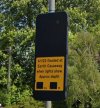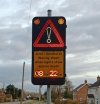There is a huge amount of ill informed fantasy on these four pages. It might be useful to share something called the ALARP principle, which is very widespread in the field of U.K. Health and Safety management.
This principle states that the risk of hazards should be reduced to a level which is As Low As Reasonably Practicable. Hazards cannot normally be eliminated without significant structural / procedural changes - eg closing this road. So the hazards should be reduced to the lowest *reasonable* level.
For anyone interested, the HSE gives a very good explanation of ALARP at the following page:

www.hse.gov.uk
The key question is around reasonableness - what actions would be considered enough to reduce the risk of a hazard to a level ALARP, without being grossly disproportionate to the risk?
To help with this assessment, the HSE helpfully publish sample calculations and costs for key injury types (fatalities, major, minor etc), to allow a cost-benefit analysis to be completed. Of particular note, one of the fully-worked examples considers the cost of implementing a control measure at a chemical factory to remove the risk of an explosion, which has the potential to kill 20 people, give 40 life-changing injuries, severely injure 100 and give minor injuries to 200 people. Think of an event something like ten times worse than the Buncefield oil terminal fire.
In the example, the incident is assessed to have a risk of occurring once in 100,000 years, and the lifetime of the plant is 25 years. Using the HSE’s estimation of costs, the “benefit” of removing this risk is about £9.5k (at 2003 prices - adjusting for inflation that’s about £14.5k today). Adding in a 10x margin of error to cover the “grossly disproportionate” definition of “reasonably practicable”, it brings us to a cost of £145 k. In other words, if the cost of the control measure to remove this hazard is higher than £145k, it would be viewed in these circumstances to be unnecessary.
The full link to this calculation is below if anyone wants to read in more detail than my summary:

www.hse.gov.uk
I’ll be honest, I nearly fell off my chair the first time I saw this approach to costing health and safety. Our culture is so risk averse, and happy to throw money at problems (look at the costs we pay for medicines…) yet this calculation apparently puts so little cost on so much injury and pain. I found it truly staggering.
But after some time considering it, I realised that the biggest weighting on the cost was because of the vanishingly small likelihood of the event happening in the first place. That’s the key to all of this.
People are generally bad at dispassionately assessing the likelihood of an event, so often this can be overstated by several orders of magnitude. The whole reason for using the HSE’s calculation is that it balances the need for safety with pragmatism, and means we don’t all have to walk around Tescos wearing high-vis vests on top of astronaut suits and knee pads. We need to be realistic about the likelihood of risks - for instance, how often has an event happened, and how many similar situations are there (eg there are lots of oil terminals, but they blow up very rarely indeed).
It wouldn’t be wise to comment on the CBA or assessment of the hazard for this incident, especially in light of the ongoing coroner’s investigations. But I thought it might be helpful to explain this principle for anyone advocating blindly throwing money at attempts to remove a hazard.



